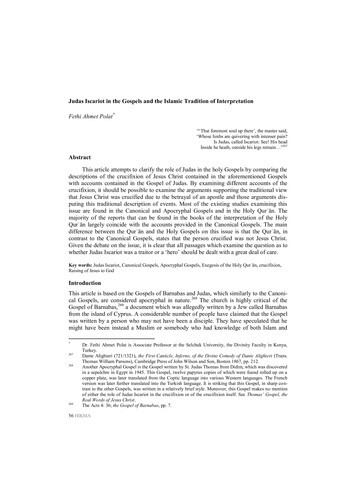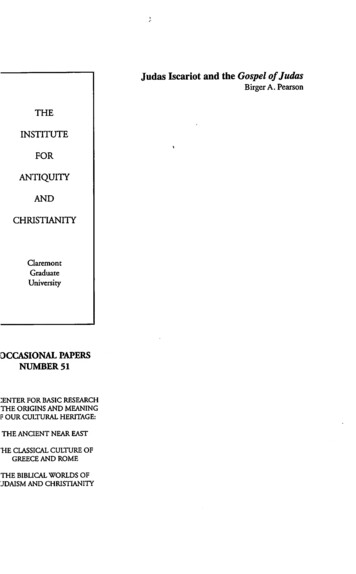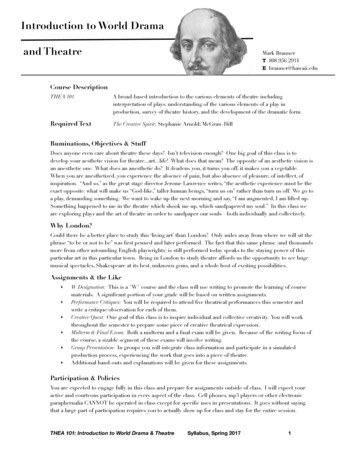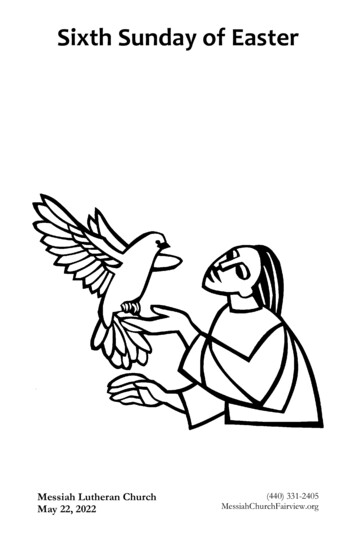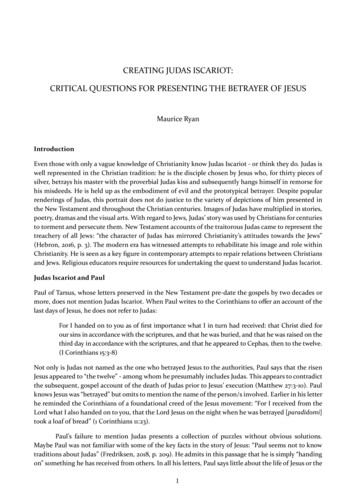
Transcription
CREATING JUDAS ISCARIOT:CRITICAL QUESTIONS FOR PRESENTING THE BETRAYER OF JESUSMaurice RyanIntroductionEven those with only a vague knowledge of Christianity know Judas Iscariot - or think they do. Judas iswell represented in the Christian tradition: he is the disciple chosen by Jesus who, for thirty pieces ofsilver, betrays his master with the proverbial Judas kiss and subsequently hangs himself in remorse forhis misdeeds. He is held up as the embodiment of evil and the prototypical betrayer. Despite popularrenderings of Judas, this portrait does not do justice to the variety of depictions of him presented inthe New Testament and throughout the Christian centuries. Images of Judas have multiplied in stories,poetry, dramas and the visual arts. With regard to Jews, Judas’ story was used by Christians for centuriesto torment and persecute them. New Testament accounts of the traitorous Judas came to represent thetreachery of all Jews: “the character of Judas has mirrored Christianity’s attitudes towards the Jews”(Hebron, 2016, p. 3). The modern era has witnessed attempts to rehabilitate his image and role withinChristianity. He is seen as a key figure in contemporary attempts to repair relations between Christiansand Jews. Religious educators require resources for undertaking the quest to understand Judas Iscariot.Judas Iscariot and PaulPaul of Tarsus, whose letters preserved in the New Testament pre-date the gospels by two decades ormore, does not mention Judas Iscariot. When Paul writes to the Corinthians to offer an account of thelast days of Jesus, he does not refer to Judas:For I handed on to you as of first importance what I in turn had received: that Christ died forour sins in accordance with the scriptures, and that he was buried, and that he was raised on thethird day in accordance with the scriptures, and that he appeared to Cephas, then to the twelve.(I Corinthians 15:3-8)Not only is Judas not named as the one who betrayed Jesus to the authorities, Paul says that the risenJesus appeared to “the twelve” - among whom he presumably includes Judas. This appears to contradictthe subsequent, gospel account of the death of Judas prior to Jesus’ execution (Matthew 27:3-10). Paulknows Jesus was “betrayed” but omits to mention the name of the person/s involved. Earlier in his letterhe reminded the Corinthians of a foundational creed of the Jesus movement: “For I received from theLord what I also handed on to you, that the Lord Jesus on the night when he was betrayed [paradidomi]took a loaf of bread” (1 Corinthians 11:23).Paul’s failure to mention Judas presents a collection of puzzles without obvious solutions.Maybe Paul was not familiar with some of the key facts in the story of Jesus: “Paul seems not to knowtraditions about Judas” (Fredriksen, 2018, p. 209). He admits in this passage that he is simply “handingon” something he has received from others. In all his letters, Paul says little about the life of Jesus or the1
characters known to us from the gospels. Paul’s agenda consumed his writings and subsumed interestin the details of Jesus’ biography. Paul may have been aware of the demise of Judas, but the idea of “thetwelve” was so ingrained in the story of the Jesus movement that “‘The Twelve’ went by that title whetheror not there were twelve of them” (Sanders, 1985, p. 101).Betrayal or Handing Over?Another intriguing aspect of Paul’s letter is that he uses the same Greek verb (paradidomi) to refer tothe act of handing over information and to the process of Jesus being handed over on the night he brokebread with his followers. It may have been his intention to identify God as the one who handed Jesusover - rather than any human actor - so Paul intentionally downplays the role of Judas in the drama.When Paul uses the same Greek word, paradidomi in relation to Jesus, he refers to the actions of God,not a human. Take, for example, his mention in his letter to the Romans: “If God is for us, who is againstus? He who did not spare his own son, but handed him over [paradidomi] for all of us - how will he notgive us all things with him?” (Romans 8:32).The precise translation of paradidomi is contested, with most translators rendering the meaningas “betrayed”. The word has a range of meanings: “to hand over, to deliver up, to relinquish/surrender(someone/something), to grant, to hand down, to transmit, to narrate/report” (Renger, 2013, p. 3). Itcould mean to give oneself up (Fredriksen, 2018, p. 209). Paradidomi could be used to convey a range ofmeanings – some sinister, others more benign. Some of these benign meanings provide a less pejorativeperspective than “betrayal”. Klassen (1996) argues there was not one single example in ancient Greekwhere the word paradidomi means “betrayed,” and further, that aspects such as deceit and disloyaltyare likewise absent from ancient usage of the word. Flavius Josephus used paradidomi 293 times in hisextensive writings in the New Testament era but never to communicate the word, betray (Klassen, 1996,pp. 47-58). This interpretation implies that, prior to his characterisation in the gospels, Judas’ role wasperceived in a more neutral light - handing over Jesus to Temple authorities but not operating as a liar,deceiver or betrayer. Judas performs a significant role in the unfolding of Jesus’ mission: Jesus needs tocontact the Temple authorities and Judas is the one to do what Jesus asks. Far from a traitor, Judas is anessential instrument in God’s plan.The notion of handing over requires clarification concerning what that activity specificallydenotes and why a member of Jesus’ inner circle might be involved in that process. An intriguingincident in John’s gospel is relevant. In John 18:15, “Simon Peter and another disciple followed Jesus.”The identity of this other disciple is not provided by John but this disciple “was known to the highpriest, he went with Jesus into the courtyard of the high priest.” The mention of this anonymous disciplehas encouraged some to imagine the author of John’s gospel is withholding information “which mayconceal Judas’ role as informer, that is, mediator between Jesus and Temple authorities” (Counet, 2011,p. 3). Other scholars think this unnamed intermediary may be the Beloved Disciple identified earlier inthe Fourth Gospel.Judas in the GospelsWe know surprisingly little about Judas Iscariot from the gospel accounts given the pivotal role he plays inthe accounts of Jesus’ arrest. When it comes to explaining Judas’ motivations for his actions for handingover Jesus to the Jerusalem authorities, the gospel authors are not expansive. This could be because“the gospels assume that readers are already familiar with Judas’ role in Jesus’ final hours” (Reinhartz,2007, p. 152). Each author presents Judas in a way that advances his own theological interests. Christiantradition harmonised the four accounts into a general narrative concerning Judas. This distorts theintentions of each author as well as the image of Judas presented in each case.2
Judas in MarkMark presents Judas in neutral tones. Judas is not a prominent figure, appearing only three times. He isnamed as one of the Twelve (Mark 3:19). He goes to the chief priests to negotiate the handover of Jesus(Mark 14:10-11). No indication of Judas’ motivations for this action is provided. The priests promise togive him money for his information, but money is not identified as the reason for Judas to go to themin the first place. The third mention occurs in the garden of Gethsemane where Judas arrives withmembers of the arresting party, identifying Jesus with a kiss (Mark 14:43-4). The kiss may be fulfillingthe teaching of Proverbs 27:6: “Well meant are the wounds a friend inflicts, but profuse are the kisses ofan enemy.” After the kiss, Judas is never heard from again in Mark.Mark also recounts a conversation at the last supper Jesus shares with his friends. Jesus tellsthem he is aware of activities of “one of the twelve, one who is dipping bread into the bowl with me”but he does not name that person (Mark 14:20). Jesus then alludes to a biblical passage - presumed tobe Psalm 41:9 - but does not directly quote it, as a way of explaining the significance of this act: “Evenmy close friend in whom I trusted, who ate my bread, has lifted up his heel against me” (Psalm 41:9).This reference suggests an explanation for Judas’ act in terms of a plan of divine promise and fulfilment.Mark has previously “prepared the reader for these events: betrayal and death in Jerusalem” (Fredriksen,1999, p. 119) when he quotes Jesus claiming that “the Son of Man must undergo great suffering, and berejected by the elders, the chief priests, and the scribes, and be killed, and after three days rise again”(Mark 8:31).Judas in MatthewMatthew’s account of the last supper and arrest in the garden mostly follows Mark’s account with minorvariations. Again, Judas is a bit player in the drama, mentioned only five times. Matthew includes Mark’sreport of Judas’ contact with the chief priests and introduces the motive of greed: “He said, ‘What willyou give me if I hand him over to you?’” (Matthew 26:15). The thirty pieces of silver appears to be anallusion to Zechariah 11:12 - a story of weighing the price of a person’s life and the imminent death ofa shepherd marked for execution. Scholars debate the question of what meaning is signified in thisreference to Zechariah: his story has confused bible readers over the centuries; Matthew’s mention of itclarifies little. Whatever its meaning, Matthew seems to show that, like so many other aspects of Jesus’story, this act of betrayal was foretold in Jewish scriptures and was therefore divinely ordained. Matthewincludes a scene not mentioned in any other gospel: Judas hangs himself after returning the money tothe chief priests and elders. Discussion of this scene is offered below.Judas in LukeLuke features Judas four times in his gospel. Like Matthew, he adopts a denigrating tone in explainingJudas’ actions in approaching the chief priests (Luke 22:3-6). He explains Judas’ motives by referenceto Satan having “entered into Judas called Iscariot” (Luke 22:3). The contest between Satan and Jesusis a theme that runs the length of Luke’s gospel. At the start of his public ministry, Luke describes howthe devil tempts Jesus in the wilderness (Luke 4:1-13). The devil is unsuccessful in tempting Jesus, butwithdraws from him “until an appropriate time” (Luke 4:13). The betrayal of Jesus by one of his chosenfollowers seems to be an appropriate time for the devil to re-enter the drama. In Matthew, Judas ismotivated by greed; in Luke, the devil made him do it. The offer of money comes later in Luke, as inMark’s story. The betrayal and execution of Jesus is part of an elaborate Satanic plot, where Luke contendsthat God will have the final word. In Luke, Judas is listed as: “Judas Iscariot who became a traitor” (Luke6:16). Luke uses a different word from the others - prodotes (traitor) rather than paradidomi whichprovides a small insight into Luke’s distinctive portrayal of Judas.3
Judas in JohnJudas is mentioned more often in John than the other gospels - eight times in all. John adopts a similarline to Luke, recounting Jesus saying to Simon Peter that one of the chosen twelve “is a devil” (John 6:71).John relates how “the devil had already put it into the heart of Judas son of Simon Iscariot to betray him”(John 13:2). At the final meal, Jesus invites Judas to “do quickly what you are going to do” (John 13: 27).John’s account balances perceptions about the role of Satan and the requirements of the divine plan.Jesus is the one who triggers Judas’ action by inviting him to undertake his task immediately. Only Johnhas provided any interaction between Jesus and Judas, prior to the events in Jerusalem that resulted inhis arrest. Judas complains about the price of costly perfume used by Mary of Bethany to anoint Jesus’feet when he visits her home. Judas thinks the money spent on the perfume would be better spenton supporting the poor. The gospel author comments on the insincerity of Judas’ comment and saysthat he was known as the group’s treasurer who stole money from the common purse (John 12:1-8).This identification of Judas as the group’s treasurer is not confirmed in any other gospel. Likewise, theidentification of Judas as a thief is unique to John.Arguably, we learn more about Judas Iscariot from the Fourth Gospel than we do from the otherthree. John reveals to his readers details about the public activities of Judas - group treasurer, thief,lacking compassion for the poor - but we are also afforded insight into the inner life of the man. He hasbeen entered by Satan, he is known to be a traitor by Jesus from earliest times in the gospel, he is the“consummate hypocrite” who would, for John the author, “ultimately become the epitome of those whoreject the truth” (Thatcher, 1996, p. 448). John’s portrait of Judas is more severe than the other threegospels. John takes every opportunity to show Judas as consistently wicked and vicious: “Whenever heacts, he does something shameful, whether it is thievery, disloyalty, or hypocrisy. Every single time thatJudas appears or is mentioned in the Fourth Gospel, he is said to be the one who betrays Jesus” (Wright,2009, p. 559). Like the other gospels, however, Judas’ betrayal would not defeat God’s plan of salvation.Judas and the PriestsInteraction between Judas and the priests occurs off-stage in all four gospels. In the absence of directgospel evidence, speculation among commentators has multiplied. Judas might have revealed to themJesus’ identity. He might have informed them where Jesus could be found and arrested without anyonenoticing (Ehrman, 2006, p. 21). He might have pointed out to the priests that Jesus claimed himself to bea king (Sanders, 1985, p. 328). He might have revealed to the priestly authorities that it was Jesus who wasresponsible for the raucous incident in the Temple (Crossan, 1995, p. 81). He might have communicatedthat Jesus was ready to allow himself to be handed over and that Jesus had authorised him to help doso (Klassen, 1996, p. 69). He might have told them Jesus believed himself to be the messiah and thathe was seeking to force Jesus into an open acknowledgment of his messiahship (Bond, 2004, p. 12). Or,he might have said that Jesus intended to die for the cause of liberation of humanity enslaved to sin(Bieringer, 2011, p. 307).One guess is as good as another given the silence of the gospel authors. Unfortunately, “thereis no final, satisfactory theory about why Judas should perform this act of irrational refusal” (Williams,2015, p. 33). Teachers are free to allow their students to join the scholarly speculation about this aspectof the gospel story.Was Judas One of the Twelve?The gospel authors agree that Jesus commissioned twelve men to constitute an inner circle of followers.The number twelve symbolised the hopes of Israel and the message of Jesus concerning the restorationand salvation of all Israel - all twelve tribes - in the last days (Sanders, 1985, p. 102). John does not give a4
complete list of the names of the twelve disciples specifically commissioned to promote Jesus’ mission.He does mention that there are twelve disciples, and also the fact that Judas Iscariot is one of them(John 6:70-1: “Did I not choose you, the Twelve?”). The lack of specific names for the Twelve is odd butmay reflect the reality that “a tradition about the Twelve may have had some importance in the earlyJohannine community but apparently holds no interest for the Fourth Evangelist” (Meier, 1997, p. 653).Scholars have discussed the nature of the relationship between Judas and Jesus. Few clues existto indicate the nature of that relationship. Some have pointed to Judas’ approach to Jesus in the garden a kiss - as an indicator of closeness between the two men: “The one I will kiss is the man; arrest him andlead him away under guard” (Mark 14:44). The synoptic authors all relate a kiss (though Luke’s accountintroduces a note of ambiguity since he implies a kiss but does not describe it - Luke 22:47-8). Someform of identification is necessary since the arresting officers do not seem to know Jesus; Judas’ role ispivotal in identifying him. In John, there is no kiss and Judas does not identify Jesus. His role is to locateJesus but not to reveal his identity. Jesus reveals himself to the arresting contingent in John (John 18:1-9).Judas is mentioned in all three disciple lists: in Mark 3:13-19, Matthew 10:1-4 and Luke 6:12-16.In each, twelve men are named albeit with minor variations. In each, Judas Iscariot is the final name.This is not an indication of the order of appointment but a technique to place Judas at the periphery ofthe chosen Twelve. The listing of Judas as one of the Twelve has not convinced everyone; some doubtthe historical authenticity of these disciple lists. Crossan (1995) considers Judas to be “a follower ofJesus but not one of the Twelve” (Crossan, 1995, p. 81). He argues the institution of the Twelve was afeature of life after the public ministry of Jesus, not during it; Judas was placed in the group of twelveby Christians, not by Jesus during his public ministry. These ideas have been challenged: “there is nocogent reason why the early church should have gone out of its way to invent such a troubling traditionas Jesus’ betrayal by Judas, one of his chosen Twelve” (Meier, 1997, p. 665).Some of those who question the role of Judas as a member of the Twelve raise further questionsabout his historical existence: “given the way in which New Testament texts developed the character ofJudas, it is difficult to ascertain the precise history, if any, underlying his role in the passion and deathof Jesus” (Boys, 2013, p. 74). Meier (2001) concedes that we know very little about Judas, despite theboundless theological speculation about him and the elaboration of his story in Christian imagination.Judas is “like a bird flying through the night, he darts for a moment into the lighted hall of Jesus’ministry, only to plunge again into the dark” (Meier, 2001, p. 630).Some support the view originally proposed by Phillip Vielhauer in the 1950s that the early Churchcreated the legend of Judas’ betrayal for theological reasons, that no circle of twelve disciples existed inJesus’ public ministry and that, while a disciple did betray Jesus, no identification of who did this wasknown to them, so they used references in the Hebrew bible to create Judas (Sanders, 1985, pp. 98-101).Contemporary manifestations of this view have been expressed by Paffenroth (2001) who argues thatJudas was little known to the first generation of Christians. For subsequent generations of Christians,Judas was a necessary character in the drama they wished to portray. He became “the perfect cipher onwhich to practice their art, shaping him into the man or monster that their individual stories needed”(Paffenroth, 2001, pp. 14-5).Maccoby (1992) is often quoted as the source for the idea that there never was, in fact, anhistorical Judas: he was an invention created by those with an interest in opposing Jewish influence inthe Jesus movement by telling stories of a prototypical Jewish enemy and betrayer. In this view, Judas isa character invented by later sources to account for a necessary link in the narrative chain connectingJesus’ public ministry with his arrest and interrogation by authorities in Jerusalem. This idea has beenrobustly contested in scholarly discussions5
Identifying Judas Iscariot by his NameWe can surmise very little about Judas from his name, in spite of numerous attempts by Christians tore-construct his back-story from inferences about his name. The designation “Iscariot” is used twelvetimes in the New Testament to identify Judas and to distinguish Judas Iscariot from others with thesame name mentioned in the New Testament: Judas, one of the brothers of Jesus (Mark 6:3); another ofJesus’ disciples, “Judas son of James” (Luke 6:16) or “Judas, not Iscariot” (John 14:22); and, an author ofone of the shorter letters of the New Testament - Jude/Judas.In the gospels, Judas’ name appears in two forms: nine times in the New Testament (Matthew,Luke and John) the Greek is spelled, iskariothes and three times iskarioth (the Jewish version). Scholarsdiffer as to which form is the original, though many accept that the Greek ending is more likely to be theoriginal. Regrettably, no New Testament author offers a meaning for the word, Iscariot. One possiblereason for the lack of an explanation is that the authors were aware of the meaning of Iscariot and wereconfident that their readers would likewise be aware, so no need to re-state the obvious. Alternatively, itmay be “that even the gospel writers - some thirty-five to sixty-five years after Judas’s death - no longerknew what it meant” (Ehrman, 2006, p. 146). Most scholars - though not all - accept that Iscariot is adescriptor rather than a surname, similar to the example of Mary of (the town of) Magdala, a title thatdistinguishes her from four other Mary’s mentioned in the gospels. Unfortunately, no consensus existson the meaning or significance of Iscariot. A quick survey indicates the range of possibilities.Some have claimed that Iscariot is a name derived from sica, a Latin word to describe a dagger. Thisgives rise to the Latin sicarius and Greek sikarios to mean something like, dagger man, or bandit. Theseobservers have linked Judas the Dagger-man to the Zealot movement, a radical Jewish revolutionary groupassociated with political assassinations and kidnapping. Scholarly interest heightened with the realisationthat the head of the sicarii in Jerusalem was Abba Saqqara (Ehrman, 1978). This would make Judas aviolent, revolutionary figure who advocated the overthrow of Roman rule from the Jewish homeland.Nothing in the New Testament hints at the involvement of Judas in such activities. The identificationof “Zealots and sicarii is a historical blunder that should have long since been laid to rest” (Meier,2001, p. 211). The sicarii arose as an identifiable group in 40s and 50s CE and not during Jesus’ lifetime.We are left to imagine why Judas the supposed dagger-man did not simply stab Jesus in a crowd, theusual modus operandi for the sicarii, rather than hand him over to Jerusalem authorities. Further, thelinguistic relationship between the Latin sica and the Greek Iscariot is weak, even non-existent.Sica, a curved dagger favoured by sicarii assassins in 40s and 50s CE.6
Some argue for a geographical reference, a guess that was first floated in antiquity. Some pointedto Issachar, one of the twelve tribes of Israel and the name given to a northern region of the unitedkingdom. Judas was therefore an “Issachariot.” Others have suggested that the term refers to his hometown, Kerioth (ish Kerioth would be, a man from the village of Kerioth). The book of Joshua 15:25mentions a town with this name in the region of Judea. So, Judas was a Judean from Kerioth, which, iftrue, would make him the sole southerner identified among Jesus’ named followers. If true, this wouldadd to an aura of Judas as an “outsider” to the Jesus movement that essentially comprised Galileans.However, archaeologists have not been able to confirm the contemporary existence of Kerioth: Brown(1994) observed that “there is no evidence that cities mentioned 1,200 to 600 years before were stillextant in Judas’ time” (Brown, 1994, p. 1414). Another Kerioth is mentioned in Jeremiah 48:24 (seealso Amos 2:2) but this town is in Moab. It is implausible to imagine a Moabite man as a member of aGalilean Jewish reform movement.Less popular suggestions include the idea that the word derives from an Aramaic term, isqar,meaning redhead or possessing a ruddy complexion. Nothing in the New Testament hints at any aspectof the appearance of Judas. The red beard, red hair or ruddy features (or sometimes all three) becamea standard feature of art in northern Europe in the later Middle Ages and Renaissance. The redness ofJudas is not a feature of the literature or iconography from the early Christian centuries. Scholars haveoffered guesses as to the purpose of depicting a redheaded Judas in Christian tradition: it may havebeen to set him apart from his peers, especially the other chosen disciples; to associate him with disdainfor and fear of foxes; to associate him with the pagan god, Thor, whose attributes were transferred toChristian notions of the devil; or, to play on the relationship between red hair and the conquering Danes(Mellinkoff, 1982). Whatever its derivation, the tone of Judas’ complexion does “not help very muchin attempting to understand his role in the gospels” (Cane, 2000, p. 45), although it may reveal theattitudes towards Judas of Christians from a later era.Some have traditionally argued for a connection to another Aramaic word, saqqar, meaning liar.Among the difficulties of this suggestion is that “no New Testament account has Judas lie about Jesus”(Brown, 1994, p. 1416). To hand someone over to authorities does not require or imply lying to them.Nineteenth century scholars associated the Hebrew word, skr (meaning to stop up, or suffocate)with the fact that, in Matthew’s rendering, Judas died from strangulation - his throat was stopped upwhen he hanged himself. Others offered scortea, a word derived from Latin that described a coat orleather apron. The Greek would be written Iskortia. The suggestion was that such aprons had purseswoven into them for carrying money and that Judas had the title of “purse bearer” within Jesus’entourage (in reference to John 13:29: “Judas had the common purse”). Doubts have been raised aboutthe likelihood that a purse would have been called a scortea (Cane , 2000, p. 45).The preceding examples demonstrate the extent to which scholars have multiplied possibilitiesfor the meaning of Iscariot and its potential to reveal something of the life and career of Judas. Yet, nosingle suggestion has proven decisive. Taylor (2010, p. 383) observed that “there is no simple, attestedword in the current lexica” that explains the meaning of Iscariot. Questions concerning the identity ofJudas based on his name are destined to remain unresolved.Two Accounts of the Death of JudasThe New Testament records Judas’ death in two places. Both relate the death of Judas in horrendouscircumstances; both are broadly contradictory. In fact, only Matthew and Luke - the author of Acts show any regard for the fate of Judas after the arrest of Jesus. Mark and John find no further need for himin their narratives after his role in Jesus’ demise as has been related.7
The account in Matthew 27:3-10 is the version that has featured in most Christian re-tellingsof the fate of Judas. Judas returns the money paid for handing over Jesus and with it, the Jerusalemauthorities purchase “the potter’s field” with the “blood money” - money connected with the executionof a convicted criminal. This field is named and known “to this day” as the “Field of Blood” and used asa place to bury foreigners. Judas commits suicide immediately after returning the money by hanginghimself. Specific details of the hanging are omitted - a tree? a rope? - though these details are standardfeatures of Christian depictions. The image of the purchase of a field comes from the Hebrew scriptures.Jeremiah 32:9 mentions buying a field for silver and Zechariah 11:12-13 recounts throwing thirty piecesof silver into the treasury in the Jerusalem Temple. Matthew interlaces both incidents to produce aquote he attributes to Jeremiah not found anywhere in the Jewish scriptures (Matthew 27:9-10). Thesescriptural allusions continue Matthew’s technique of fulfilment quotations where incidents in the lifeof Jesus are prefigured in the Hebrew bible and thus assume a divine mandate.Matthew’s account of Judas’ actions after handing over Jesus demonstrates an aspect of Matthew’stheological agenda: Judas, the betrayer immediately recognises the innocence of Jesus and the injusticeof his deed. A similar theme will play out in Matthew when Pontius Pilate, after interrogating Jesus,likewise can see no fault in Jesus and absolves himself of any responsibility: “I am innocent of this man’sblood; see to it yourselves” (Matthew 27:24). For Matthew, if Jesus’ betrayer sees Jesus as innocent, if theone who condemns him to death does likewise, then the only guilty parties remaining are the Jerusalempriestly authorities and the Jewish crowds who urged them on. The priestly authorities do not allowJudas to atone for his actions. In this sense, Judas is used by Matthew as a foil to advance his agenda. Heseeks to shift blame for the execution of Jesus onto the Jewish people and their leaders and away fromRoman officials.The question of the validity of the act of suicide has been discussed by scholars, some of whomargue that Judas’ death by hanging is not to be understood as a negative phenomenon within the contextof the first century CE but rather “as a noble one in which he atoned for his sin of betraying ‘innocentblood’” (Reed, 2005, p. 51). This perspective challenges traditional Christian notions of suicide. Saari(2006, p. 13) observed that people today speak “as though all the gospels relate that Judas killed himself,when in fact only Matthew does.” Saari (2006) thought that “many of the ideas Christians have aboutsuicide and about the figure of Judas come not from the scriptures themselves” (Saari, 2006, p. 13).An alternative account of the demise of Judas is found in Acts 1:18-20. After the disciples havemet with the risen Jesus and after he has ascended to heaven, the decision is made to re-constitute abody of twelve men for the sake of the mission. They must replace Judas. Here Luke features a speechby Peter proposing a replacement for Judas within the Twelve. Peter begins his speech in a manner thataccords with Luke’s agenda co
Luke features Judas four times in his gospel. Like Matthew, he adopts a denigrating tone in explaining Judas' actions in approaching the chief priests (Luke 22:3-6). He explains Judas' motives by reference to Satan having "entered into Judas called Iscariot" (Luke 22:3). The contest between Satan and Jesus
